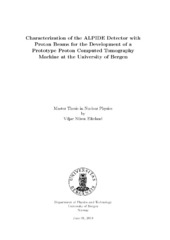| dc.contributor.author | Eikeland, Viljar Nilsen | |
| dc.date.accessioned | 2018-08-13T15:05:17Z | |
| dc.date.available | 2018-08-13T15:05:17Z | |
| dc.date.issued | 2018-07-04 | |
| dc.date.submitted | 2018-07-03T22:00:02Z | |
| dc.identifier.uri | https://hdl.handle.net/1956/18058 | |
| dc.description.abstract | In conventional radio therapy, photons is used in the treatment. Treatment with protons, however, greatly reduce the energy which is deposited in healthy tissue surrounding the tumor. The aim for the pCT group at the University in Bergen is to develop an imaging modality using protons. The motivation for this is to accurately locate the Bragg-peak, which is the region where the protons deposit the maximum of their energy. At the moment conventional CT scans are used to map the inner structures of a patient. The relation between photon attenuation and stopping power is not one-to-one. Thus this leads to uncertainties in the location of the Bragg-peak for protons. The design proposed by the pCT group at UIB is one that aims to have one detector to both track the particles and measure the energy deposition of the traversing protons. The detector which was chosen for this purpose, was the ALPIDE detector developed for the ITS upgrade at CERN. It has a high granularity and is thus able to track the protons efficiently. This thesis will look into how the ALPIDE detector efficiently measures the energy deposition of non MIP. It focuses on how the signal from the traversing particles behaves under variation of different parameters, before looking into the behavior of the ALPIDE when exposed to a high LET proton beam. Previous characterizations of the ALPIDE have focused on MIP, while this is some of the earlier work with heavier particles. The ALPIDE was able to distinguish the energy deposited with varying LET, especially in the region where the LET is constant among the particles traversing the ALPIDE, the cluster size of individual particles can be a good indication on energy deposited. It has thus shown promising signs that it will be able to perform well in the proposed setup of the prototype pCT designed by the pCT group at the University of Bergen. | en_US |
| dc.language.iso | eng | eng |
| dc.publisher | The University of Bergen | en_US |
| dc.subject | ALPIDE | |
| dc.subject | LET | |
| dc.subject | proton computer tomography | eng |
| dc.subject | protonstråling | nob |
| dc.subject | Partikkeldetektorer | nob |
| dc.subject | Sensorikk | nob |
| dc.subject | Tomografi | nob |
| dc.title | Characterization of the ALPIDE Detector with Proton Beams for the Development of a Prototype Computed Tomography Machine at the University of Bergen | en_US |
| dc.type | Master thesis | |
| dc.date.updated | 2018-07-03T22:00:02Z | |
| dc.rights.holder | Copyright the Author. All rights reserved | en_US |
| dc.description.degree | Masteroppgave i fysikk | en_US |
| dc.description.localcode | MAMN-PHYS | |
| dc.description.localcode | PHYS399 | |
| dc.subject.realfagstermer | https://data.ub.uio.no/realfagstermer/c002439 | |
| dc.subject.realfagstermer | https://data.ub.uio.no/realfagstermer/c002452 | |
| dc.subject.realfagstermer | https://data.ub.uio.no/realfagstermer/c000019 | |
| dc.subject.nus | 752199 | eng |
| fs.subjectcode | PHYS399 | |
| fs.unitcode | 12-24-0 | |
